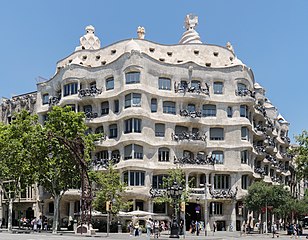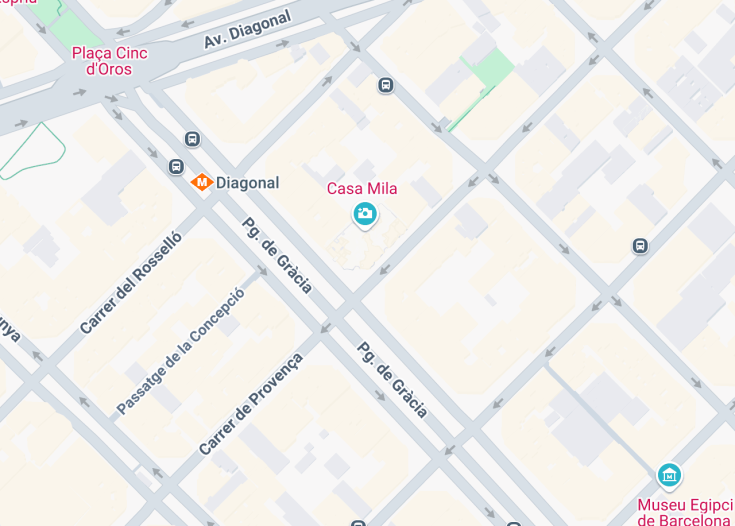Designed by the celebrated architect Antoni Gaudí, Casa Milà, also known as La Pedrera, is a prime example of Modernist architecture located in Barcelona, Spain. This iconic building, completed in 1912, is famed for its undulating stone facade and iron balconies, embodying Gaudí’s innovative vision. Casa Milà is now a UNESCO World Heritage Site, drawing visitors globally to explore its unique structure and the rooftop adorned with whimsical chimneys. The interior serves as a museum showcasing Gaudí’s work and provides insights into early 20th-century bourgeois life in Barcelona.
To fully appreciate Casa Milà, visit during the early morning or late evening to avoid the tourist crowds and experience the building in a more intimate setting.
Consider exploring the rooftop at sunset for a stunning view of Barcelona. The unique chimney shapes against the backdrop of the city make for breathtaking photographs.
Casa Mila: a masterpiece of modernism
Casa Mila, also known as La Pedrera, is a renowned architectural marvel located in the heart of Barcelona, Spain. Designed by the illustrious architect Antoni Gaudí, this building stands as a prime example of modernist architecture. Completed in 1912, Casa Mila has been a significant attraction, drawing visitors who are eager to explore its unique stone facade and whimsical design elements that defy conventional architectural norms. The structure’s undulating walls and iron balconies create a unique wave-like appearance that complements the naturalistic motifs often found in Gaudí’s work. Not only is Casa Mila celebrated for its architectural innovation, but it also hosts exhibitions and provides insight into Gaudi’s approach to design through a visit to the attic, which houses the Gaudí Exhibition. A cultural landmark, it has been designated as a UNESCO World Heritage Site, and continues to influence contemporary architecture globally.
Exploring the architectural wonders of Casa Mila
Visitors to Casa Mila can anticipate a host of intriguing sights and activities. The roof terrace, with its iconic chimney sculptures, offers panoramic views of Barcelona and a close look at Gaudí’s innovative use of space and design. The whimsical forms and the intricate tile work reflect Gaudí’s deep connection to natural forms and his unorthodox approach to architectural design. Inside, you can explore a preserved apartment showing what a bourgeois home would have looked like in the early 20th century, providing a glimpse into historical lifestyles powered by modernist design.
The attic and the Gaudí Exhibition at Casa mila
A visit to the attic of Casa Mila offers a deep dive into the mind of Antoni Gaudí. This space, originally designed as a laundry room, now houses the Gaudí Exhibition. The attic itself is an architectural marvel, featuring a mesmerizing series of catenary arches that create a striking wave-like effect. The Gaudí Exhibition provides valuable insights into his unique techniques and materials, offering visitors a comprehensive understanding of his innovative approach to architecture, which significantly shaped the modernist movement in architecture.
Explore the wonders of casa mila
Casa Mila, also known as La Pedrera, is a must-visit destination for everyone from art enthusiasts to families with children and elderly visitors. This architectural marvel offers a unique experience with its undulating stone facade and whimsical chimney pots, designed by the legendary Antoni Gaudí. Visitors can expect to immerse themselves in a blend of artistic creativity and historical significance, making it an unforgettable part of any cultural journey.
Discover the best time to experience casa mila
Visiting Casa Mila is enchanting all year round, but the ideal times are during the spring and autumn months. These seasons offer pleasant weather, making it more comfortable to explore the rooftop and enjoy the rich details of Gaudí’s work without the rush of peak tourist seasons.
Annual highlights
Casa Mila hosts several engaging events, with the ‘La Pedrera Night Experience’ being a standout. This evening tour provides a magical illumination of the architecture accompanied by a visual show that highlights the unique features of Gaudí’s design.
Accessibility and visitor information
Casa Mila is committed to accessibility, ensuring that everyone can enjoy the grandeur of Gaudí’s creation.
Accessibility
Limitations
To maintain the integrity of the site and its exhibits, Casa Mila enforces several limitations:
- No large bags or backpacks
- No food or drinks inside the exhibition areas
- Photos without flash are permitted
Notes to visitors
While not strictly enforced, visitors are encouraged to:
- Dress comfortably and appropriately for the weather
- Use the audio guides available for a more informative experience
General informations
Prepare for your journey to casa mila
Location
Casa Mila is located in the heart of the city, close to other major attractions and easily accessible by public transport.
Address:
Passeig de Gràcia, 92, 08008 Barcelona, Spain
Opening hours
Casa Mila is open daily from 9:00 AM to 8:30 PM. The building is closed on significant public holidays and occasionally for maintenance.
Directions to casa mila
Reaching Casa Mila is straightforward from any part of the city.
By Car
Driving to Casa Mila is an option, with several parking lots available in the vicinity.
| Route | Distance | Travel time |
|---|---|---|
| From Barcelona Airport | 15 km | 20 minutes |
| From Las Ramblas | 3 km | 10 minutes |
| From Sagrada Familia | 2 km | 5 minutes |
Public transit such as buses and metro are also available and are often more convenient due to heavy city traffic.
Nearby Attractions
Other popular destinations near Casa Mila include:
- La Sagrada Familia – 2 km (1.24 miles)
- Barcelona Cathedral – 2.5 km (1.55 miles)
- Park Güell – 4 km (2.48 miles)
- Palau de la Música Catalana – 1.5 km (0.93 miles)
- Barceloneta Beach – 5 km (3.1 miles)
- Montjuïc Castle – 7 km (4.35 miles)
- Torre Glòries – 2 km (1.24 miles)
- Las Ramblas – 3 km (1.86 miles)
- Plaça d’Espanya – 3 km (1.86 miles)
- Camp Nou – 5 km (3.1 miles)
- Picasso Museum – 2 km (1.24 miles)
- Passeig de Gracia – 0.1 km (0.06 miles)
Common questions
What architectural style is Casa Mila designed in?
What are the main attractions within Casa Mila?
- The Roof Terrace: This is famous for its surreal chimney pots, which are covered in trencadis (a type of mosaic made from broken tile shards), and sculptural skylights resembling knights.
- The Espai Gaudí: Located in the attic, this museum is dedicated to Gaudí’s work and techniques, displaying models, drawings, photographs, and videos.
- The Pedrera Apartment: A reproduction of an early 20th-century bourgeois family home providing insights into the lifestyle during Gaudí’s time.
- The Courtyards: Casa Mila features two large, colorful courtyards that are architecturally significant and provide vital light and ventilation to the inner apartments.
- Exhibition Hall: This was the former residence of the Milà family and sometimes hosts temporary art exhibitions.
Each part of Casa Mila showcases Gaudí’s unparalleled ability to integrate naturalistic elements with architectural ingenuity.
Can you take photos inside Casa Mila?
Is there any dress code to visit Casa Mila?
What kind of accessibility does Casa Mila offer for visitors with disabilities?
What unique architectural features distinguish Casa Mila?
- Self-supporting stone facade: Unlike traditional buildings which require load-bearing walls, Casa Mila’s facade is self-supporting, allowing for larger windows and more open interior spaces.
- Wavy stone work and forged iron: The exterior is notable for its undulating stone work, complemented by intricate forged iron that decorates balconies and windows.
- Catenary arches: Inside, the structure uses catenary arches that provide a robust construction without the use of buttresses.
- Natural ventilation system: Gaudí designed Casa Mila with an ingenious ventilation system that allows natural air flow throughout, reducing the need for artificial methods.
These features not only enhance the aesthetic appeal of the building but also demonstrate Gaudí’s innovative approach to architecture.
How long does a typical visit to Casa Mila last?
Are there guided tours available at Casa Mila?
What materials were used in the construction of Casa Mila?
Can you describe the influence of nature on the design of Casa Mila?
What historical significance does Casa Mila hold in Barcelona?
What conservation efforts are in place for Casa Mila?

Is Casa Mila in Barcelona worth visiting?
Casa Mila, also known as La Pedrera, stands out as one of Barcelona’s architectural marvels, designed by the celebrated architect Antoni Gaudí. This building is famed for its wave-like stone facade and whimsical chimney pots, aspects that are quintessentially Gaudian in style and attract large volumes of visitors each year.
However, tourists should be aware that the popularity of Casa Mila can lead to significant crowds and long waiting times, particularly during peak tourist seasons. While the interior and the rooftop offer unique views and designs, the experience might feel rushed and crowded. Those with a keen interest in architecture or Gaudí’s works might find it more worthwhile than casual tourists looking for a quick cultural stop. Therefore, whether Casa Mila is worth visiting depends significantly on personal interests and tolerance for crowds.









